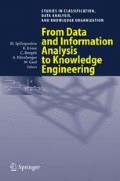Abstract
Iterative fuzzy clustering algorithms are sensitive to initialization. Swarm based clustering algorithms are able to do a broader search for the best extrema. A swarm inspired clustering approach which searches in fuzzy cluster centroids space is discussed. An evaluation function based on fuzzy cluster validity was used. A swarm based clustering algorithm can be computationally intensive and a data distributed approach to clustering is shown to be effective. It is shown that the swarm based clustering results in excellent data partitions. Further, it shown that the use of a cluster validity metric as the evaluation function enables the discovery of the number of clusters in the data in an automated way.
Access this chapter
Tax calculation will be finalised at checkout
Purchases are for personal use only
Preview
Unable to display preview. Download preview PDF.
References
BEZDEK, J.C., KELLER, J., KRISHNAPURAM, R., and PAL, N. (1999): Fuzzy Models and Algorithms for Pattern Recognition and Image Processing. Kluwer, Boston, MA.
BLAKE, C.L., and MERZ, C.J. (1998): UCI repository of machine learning databases. http://www.ics.uci.edu/~mlearn/MLRepository.html.
HALL, L.O., and KANADE, P.M. (2005): Swarm based fuzzy clustering with partition validity. Proc. 14th IEEE Int. Conf. on Fuzzy Systems (FUZZ-IEEE’05). IEEE Press, Piscataway, NJ. To Appear.
HANDL, J., KNOWLES, J., and DORIGO, M. (2003a): On the performance of antbased clustering. design and application of hybrid intelligent systems. Frontiers in Artificial intelligence and Applications 104, 204–213.
HANDL, J., KNOWLES, J., and DORIGO, M. (2003b): Strategies for the increased robustness of ant-based clustering. Self-Organising Applications: Issues, challenges and trends, LNCS 2977, 90–104. Springer-Verlag, Berlin.
HATHAWAY, R.J., and BEZDEK, J.C. (1995): Optimization of clustering criteria by reformulation. IEEE Trans. on Fuzzy Systems, 3(2):241–245. IEEE Press, Piscataway, NJ.
HORE, P. (2004): Distributed clustering for scaling classic algorithms. Master’s thesis, University of South Florida, Tampa, FL.
HORE, P., and HALL, L.O. (2004): Distributed clustering for scaling classic algorithms. Proc. 13th IEEE Int. Conf. on Fuzzy Systems (FUZZ-IEEE’04). IEEE Press, Piscataway, NJ.
KANADE, P. (2004): Fuzzy ants as a clustering concept. Master’s thesis, University of South Florida, Tampa, FL.
KANADE, P.M., and HALL, L.O. (2004): Fuzzy ants clustering with centroids. Proc. 13th IEEE Int. Conf. on Fuzzy Systems (FUZZ-IEEE’04). IEEE Press, Piscataway, NJ.
KIM, D.W., LEE, K.H., and LEE, D. (2004): A novel initialization scheme for the fuzzy c-means algorithm for color clustering. Pattern Recognition Letters, 25(2):227–237.
LABROCHE, N., MONMARCHE, N., and VENTURINI, G. (2002): A new clustering algorithm based on the chemical recognition system of ants. Proc. European Conf. on Artificial Intelligence, 345–349.
MONMARCHÉ, N., SLIMANE, M., and VENTURINI, G. (1999): On improving clustering in numerical databases with artificial ants. Proc. 5th European Conf. on Artificial Life (ECAL’99), LNAI 1674, 626–635. Springer-Verlag, Berlin.
OUADFEL, S., and BATOUCHE, M. (2002): Unsupervised image segmentation using a colony of cooperating ants. Biologically Motivated Computer Vision, 2nd Int. Workshop, BMCV 2002, LNCS 2525, 109–116. Springer-Verlag, Berlin.
PAL, N.R., and BEZDEK, J.C. (1995): On cluster validity for the fuzzy c-means model. IEEE Trans. on Fuzzy Systems, 3(3):370–379.
ULTSCH, A. (2004): Strategies for an artificial life system to cluster high dimensional data. Abstracting and Synthesizing the Principles of Living Systems, GWAL-6, 128–137.
XIE, X.L., and BENI, G.A. (1991): Validity measure for fuzzy clustering. IEEE Trans. on Pattern Analysis and Machine Intelligence, 3(8):841–846.
Author information
Authors and Affiliations
Editor information
Editors and Affiliations
Rights and permissions
Copyright information
© 2006 Springer Berlin · Heidelberg
About this paper
Cite this paper
Hall, L.O., Kanade, P.M. (2006). Scalable Swarm Based Fuzzy Clustering. In: Spiliopoulou, M., Kruse, R., Borgelt, C., Nürnberger, A., Gaul, W. (eds) From Data and Information Analysis to Knowledge Engineering. Studies in Classification, Data Analysis, and Knowledge Organization. Springer, Berlin, Heidelberg. https://doi.org/10.1007/3-540-31314-1_3
Download citation
DOI: https://doi.org/10.1007/3-540-31314-1_3
Publisher Name: Springer, Berlin, Heidelberg
Print ISBN: 978-3-540-31313-7
Online ISBN: 978-3-540-31314-4
eBook Packages: Mathematics and StatisticsMathematics and Statistics (R0)

